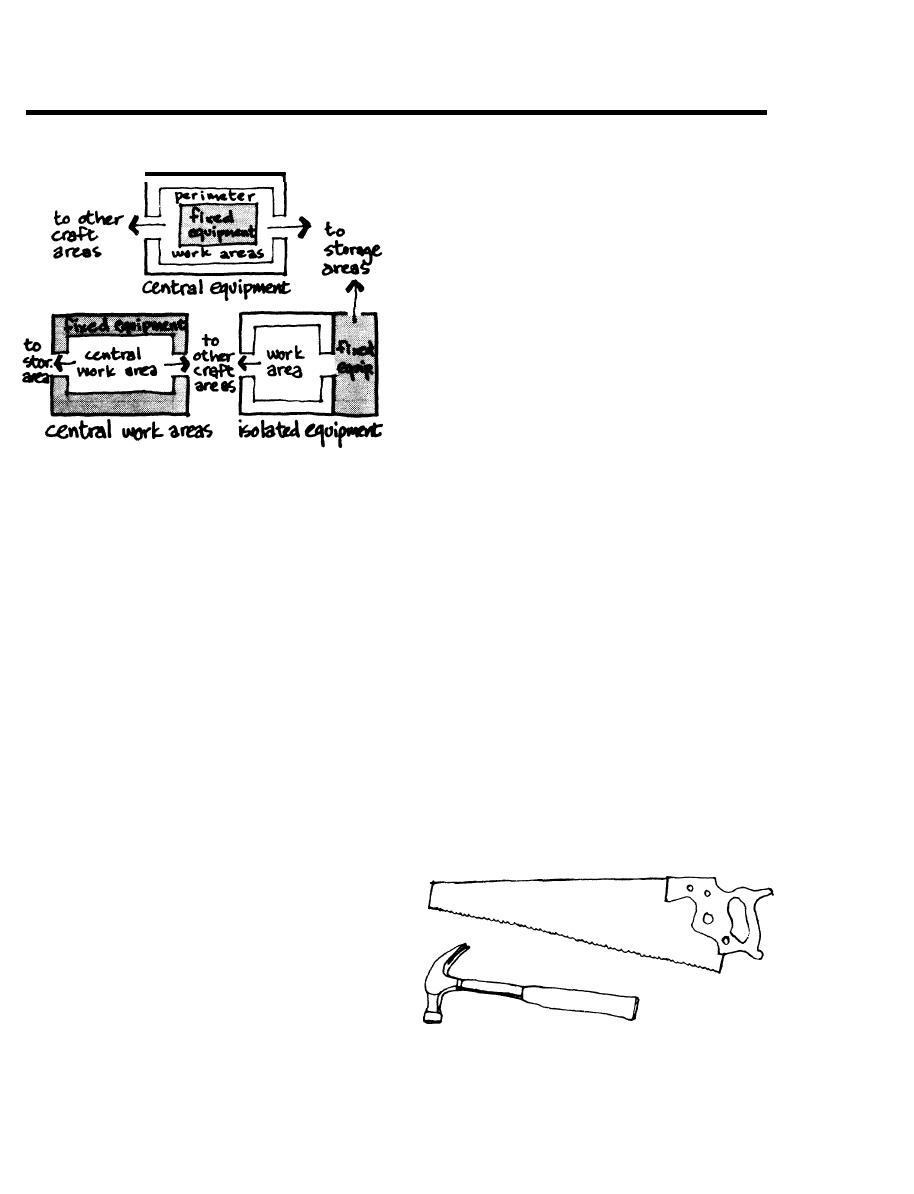
Page 45
DG 1110-3-124
August 1976
Shop Arrangements
more difficult to reach for maintenance and generally
more expensive than an overhead system. In either case,
all secondary runs must enter main ducts at acute angles,
and clean out points should be provided at all angular con-
nections. Extra hookup points should be provided for
future equipment needs and for use as a built-in vacuum
cleaning system. For safety, noise reduction and waste dis-
posal, dust collection hoppers and fans should be placed
outside.
(2) Woodworking power equipment generates a high
noise level. Within prudent construction limitations,
sound absorbent materials should be used on ceilings and
walls in fixed equipment areas. Sound insulation pads
should be used under the bases of rotating, vibrating, or
impact machinery. Noisy equipment may be sound iso-
lated from other work areas by solid walls or double-
glazed safety-glass partitions.
(3) Adequate ventilation, temperature, and relative
fixed power tools should be surrounded by "safety
humidity controls are design considerations that affect the
islands" marked with tape and should be separated from
usefulness of the spaces. Relative humidity should be
genera! circulation and arranged so that ample space is
maintained at a level to prevent the surface oxidation of
provided for the operator and task. Aisles should be
tools and machines and the delamination of wood joints.
generous enough to permit free two-way passage. Work-
The ventilation system design must take into considera-
benches should be grouped and spaced according to sizes
tion the required air changes per occupant, and the
of anticipated projects. Tools and equipment should be of
exhaust system of the power tools. Spray booths must
industrial quality. Each machine must have a guard
have exhaust fans.
attached and locked on and a safety cut-off switch in
addition to the master switch for the area. Power tools
(4) In particular, lumber storage and finishing areas must
should be grounded. Floors should have a non-slip finish.
be sprinklered. At least one service sink with hot and cold
Color coding machinery will contribute to safe operations.
water should be provided. A sink with sediment trap is
It is recommended that the center's director and the
desirable in or near the finishing room.
supervisors of the woodworking activities become familiar
with the safety requirements for woodworking power
(5) Proper lighting reduces accidents. A minimum of 70
tools as set forth in the Occupational Safety and Health
Act of 1970.
be maintained at working surface height.
(2) The following list notes the major items of equipment
(6) The finishing room requires explosive free fixtures
which are typical for a woodworking facility of approxi-
and switches. Circuit breakers must be provided for each
mately 7,225 square feet: Radial arm saws, wood lathes,
machine. Outlets should be convenient to work stations
four-station work benches, band saws, drill presses, jig
for portable power tool use. A main power panel must be
saws, circular saws, disc sanders, belt/disc sanders, joint-
located at the supervisor's station.
ers, shapers, panel saws, surface planers, hand tools, vises,
lockers, and storage cabinets.
g.
TECHNOLOGICAL
REQUIREMENTS
(1) A dust removal system is an important feature for the
safe operations of power equipment. This should be
placed underfIoor or overhead and be fitted with flexible
hose connections. In new construction, the more pre-
ferred underfloor system provides a permanent, relatively
quiet, obstruction free installation but it is less flexible,


 Previous Page
Previous Page
